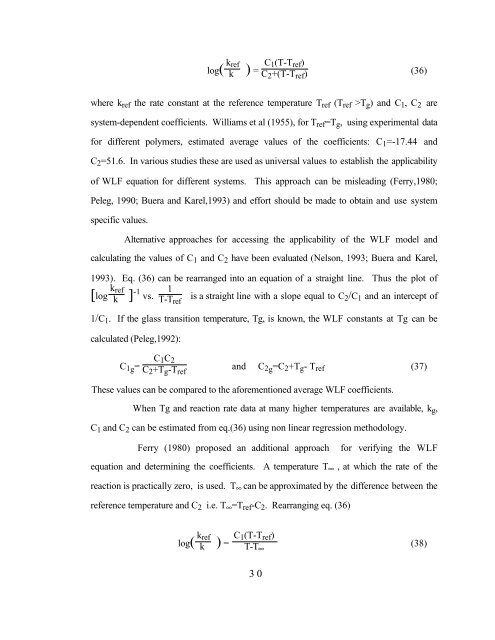the handbook of food engineering practice crc press chapter 10 ...
the handbook of food engineering practice crc press chapter 10 ...
the handbook of food engineering practice crc press chapter 10 ...
Create successful ePaper yourself
Turn your PDF publications into a flip-book with our unique Google optimized e-Paper software.
log( k ref<br />
k ) = C 1(T-T ref )<br />
C 2 +(T-T ref ) (36)<br />
where k ref <strong>the</strong> rate constant at <strong>the</strong> reference temperature T ref (T ref >T g ) and C 1 , C 2 are<br />
system-dependent coefficients. Williams et al (1955), for T ref =T g , using experimental data<br />
for different polymers, estimated average values <strong>of</strong> <strong>the</strong> coefficients: C 1 =-17.44 and<br />
C 2 =51.6. In various studies <strong>the</strong>se are used as universal values to establish <strong>the</strong> applicability<br />
<strong>of</strong> WLF equation for different systems. This approach can be misleading (Ferry,1980;<br />
Peleg, 1990; Buera and Karel,1993) and effort should be made to obtain and use system<br />
specific values.<br />
Alternative approaches for accessing <strong>the</strong> applicability <strong>of</strong> <strong>the</strong> WLF model and<br />
calculating <strong>the</strong> values <strong>of</strong> C 1 and C 2 have been evaluated (Nelson, 1993; Buera and Karel,<br />
1993). Eq. (36) can be rearranged into an equation <strong>of</strong> a straight line. Thus <strong>the</strong> plot <strong>of</strong><br />
[log k ref 1<br />
k ]-1 vs. T-T ref<br />
is a straight line with a slope equal to C 2 /C 1 and an intercept <strong>of</strong><br />
1/C 1 . If <strong>the</strong> glass transition temperature, Tg, is known, <strong>the</strong> WLF constants at Tg can be<br />
calculated (Peleg,1992):<br />
C 1 g = C 1 C 2<br />
C 2 +T g -T ref<br />
and C 2 g =C 2+T g - T ref (37)<br />
These values can be compared to <strong>the</strong> aforementioned average WLF coefficients.<br />
When Tg and reaction rate data at many higher temperatures are available, k g ,<br />
C 1 and C 2 can be estimated from eq.(36) using non linear regression methodology.<br />
Ferry (1980) proposed an additional approach for verifying <strong>the</strong> WLF<br />
equation and determining <strong>the</strong> coefficients. A temperature T ∞ , at which <strong>the</strong> rate <strong>of</strong> <strong>the</strong><br />
reaction is practically zero, is used. T ∞ can be approximated by <strong>the</strong> difference between <strong>the</strong><br />
reference temperature and C 2 i.e. T ∞ =T ref -C 2 . Rearranging eq. (36)<br />
log( k ref<br />
k ) = C 1(T-T ref )<br />
T-T ∞<br />
(38)<br />
30














